The Imperial Calendar
The Known World takes 400 days to travel around its sun, a much larger and hotter star than our own and is orbited by two moons.
The larger of these - known in The Empire as Mannslieb ("Beloved of Manann") - has a cycle of 25 days from full to full and looks not unlike the moon of our own world.
The other - named Morrslieb ("Beloved of Mórr") - is erratic, appearing occasionally closer, and at other times further away than its partner.
There are two main legends concerning the origins and nature of Morrslieb.
According to the first, it was once a gateway in the sky, through which daemons came to prey upon the people of the Known World. Mórr inflicted a great and terrible death upon them and fashioned the second moon out of the wreckage so that mortals would never forget how the god had saved them.
The second legend maintains that when Chaos first broke through into the Known World, a great block of Warpstone was hurled high into the sky, where it circles endlessly, spreading Chaos on the lands over which it passes. This legend is believed mainly by the followers of Chaos, who hold festivals when Morrslieb is full. (Morrslieb's orbit is chaotic and cannot be predicted more than a few days in advance. However, it is always full on Hexensnacht and Geheimnisnacht.)
Seasonal Dates
The following dates are recognised as important seasonal dates during the Imperial Year.- First day of Spring is the 17th Day of Nachexen.
- First day of Summer is the 18th Day of Sigmarzeit.
- First day of Autumn is the 17th Day of Nachgeheim.
- First day of Winter is the 18th Day of Kaldezeit.
- Series 1: Years ending in 00, 04, 08, 12, 16, 20, 24, 28, 32, 36, 40, 44, 48, 52, 56, 60, 64, 68, 72, 76, 80, 84, 88, 92, or 96 begin on Wellentag.
- Series 2: Years ending in 01, 05, 09, 13, 17, 21, 25, 29, 33, 37, 41, 45, 49, 53, 57, 61, 65, 69, 73, 77, 81, 85, 89, 93, or 97 begin on Marktag.
- Series 3: Years ending in 02, 06, 10, 14, 18, 22, 26, 30, 34, 38, 42, 46, 50, 54, 58, 62, 66, 70, 74, 78, 82, 86, 90, 94, or 98 begin on Bezahltag.
- Series 4: Years ending in 03, 07, 11, 15, 19, 23, 27, 31, 35, 39, 43, 47, 51, 55, 59, 63, 67, 71, 75, 79, 83, 87, 91, 95, or 99 begin on Angestag.
Imperial Calendar - Series 1
Imperial Calendar - Series 2
Imperial Calendar - Series 3
Imperial Calendar - Series 4
Months and Festivals
There are almost as many calendars in the Known World as there are races and countries, but the one shown above is standard throughout The Empire (and, inevitably, in the kingdoms and countries around it). The Imperial calendar divides the year into 12 months of 32 or 33 days and includes six intercalary days that fall between months and are not numbered. Four of these are festivals connected to seasonal events - the summer and winter solstices and the spring and autumn equinoxes - while the other two mark the occasions when both moons are full. These last are greatly feared and even the most hardened cynics stay out of the eerie light cast by the moons on Hexensnacht ("Witching Night") and Geheimnisnacht ("Night of Mystery"). The months may be translated as- Nachexen - "After-Witching",
- Jahrdrung - "Year-Turn",
- Pflugzeit - "Ploughtide",
- Sigmarzeit - "Sigmar-tide",
- Sommerzeit - "Summertide",
- Vorgeheim - "Fore-Mystery",
- Nachgeheim - "After-Mystery",
- Erntezeit - "Harvest-tide",
- Brauzeit - "Brewmonth",
- Kaldezeit - "Chillmonth",
- Ulriczeit - "Ulric-tide",
- and Vorhexen - "Fore-Witching".
| Date | Festival or Deity Worshipped |
|---|---|
| Hexentag (Witching Day) | The Old Faith, Liadriel (Elves) |
| 1st day of Nachexen | Verena (Empire) |
| Mitterfruhl (Spring Equinox) | Manann, Taal, Ulric, (The Old Faith) |
| 33rd day of Pflugzeit | Grungni (Dwarves) |
| 18th day of Sigmarzeit | Sigmar (Empire) |
| Sonnstill (Summer Solstice) | (The Old Faith) |
| 33rd day of Vorgeheim | Grungni (Dwarves) |
| Geheimnistag (Day of Mystery) | The Old Faith, Liadriel (Elves) |
| 1st to 8th day of Erntezeit | Esmeralda (Halfling Pie Week) |
| Mittherbst (Autumn Equinox) | Ulric (The Old Faith) |
| 33rd day of Brauzeit | Grungni (Dwarves) |
| Mondstille (Winter Soltice) | Ulric (The Old Faith) |
| 33rd day of Vorhexen | Grungni (Dwarves) |
Days of the Week
There are eight days in the Imperial week, whose names probably date back to pre-Empire times: Wellentag, Aubentag, Marktag, Backertag, Bezahltag, Konistag, Angestag, Festag. In order, they could be translated as "Workday", "Levyday", "Marketday", "Bakeday", "Taxday", "Kingday", "Startweek", and "Holiday". However, the reasons for such names are now largely forgotten - a market day can be any day of the week, depending on where you go in the Empire, while holidays vary according to the deities worshipped in the local temples. Of the eight days of the week, Festag is technically a day of rest, reserved for Worship. Shops should be shut and no work or trade is done. However, this varies from area to area, depending on the harshness of the local ruler and the amount of hold that priests and temples have over the local community. Within The Empire, major festivals and feast-days do not fall on a day of the week. This gives these festivals an extra emphasis, making them stand apart from the rest of the week. Festivals and feast-days are not normal days, they are important events in the religions and beliefs of the Old World and they are far more than an excuse for a day off. Anyone who expects to find people conducting normal business on a festival-day is going to be disappointed. There are other feast-days in the calendar, but most of them are only observed in certain areas or by certain groups of people. A day sacred to Verena will be observed by scholars, scribes, lawyers, and any profession linked to learning or justice, for example. Towns and cities will have special holidays in memory of local heroes or major days in the area's history, such as the ending of a siege, a famous victory, the overthrowing of a tyrant, or the anniversary of the birth or death of a well-loved ruler.Months
Nachexen - "After-Witching",
Jahrdrung - "Year-Turn",
Pflugzeit - "Ploughtide",
Sigmarzeit - "Sigmar-tide",
Sommerzeit - "Summertide",
Vorgeheim - "Fore-Mystery",
Nachgeheim - "After-Mystery",
Erntezeit - "Harvest-tide",
Brauzeit - "Brewmonth",
Kaldezeit - "Chillmonth",
Ulriczeit - "Ulric-tide",
and Vorhexen - "Fore-Witching".
Days of the Week
Wellentag - "Workday"
Aubentag - "Levyday",
Marktag - "Marketday",
Backertag - "Bakeday",
Bezahltag - "Taxday",
Konistag - "Kingday",
Angestag - "Startweek",
Festag - "Holiday".
Major Festivals
Hexenstag - The Old Faith, Liadriel
1 Nachexen - Verena
Mitterfruhl - Manann, Taal, Ulric, The Old Faith
33 Pflugzeit - Grungni
18 Sigmarzeit - Sigmar
10 Summerzeit - Day Of Folly
Sonnstill - The Old Faith
33 Vorgeheim - Grungni
Geheimnistag - The Old Faith, Liadriel
1-8 Erntezeit - Esmeralda ("Pie Week")
Mittherbst Ulric, - The Old Faith
33 Brauzeit - Grungni
Mondstille - Ulric, The Old Faith
33 Vorhexen - Grungni

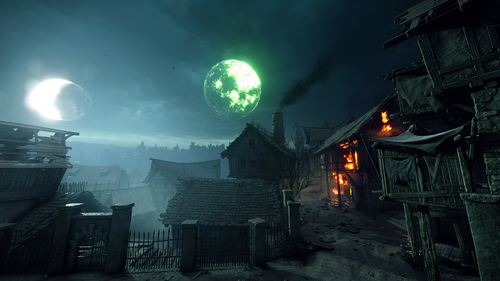
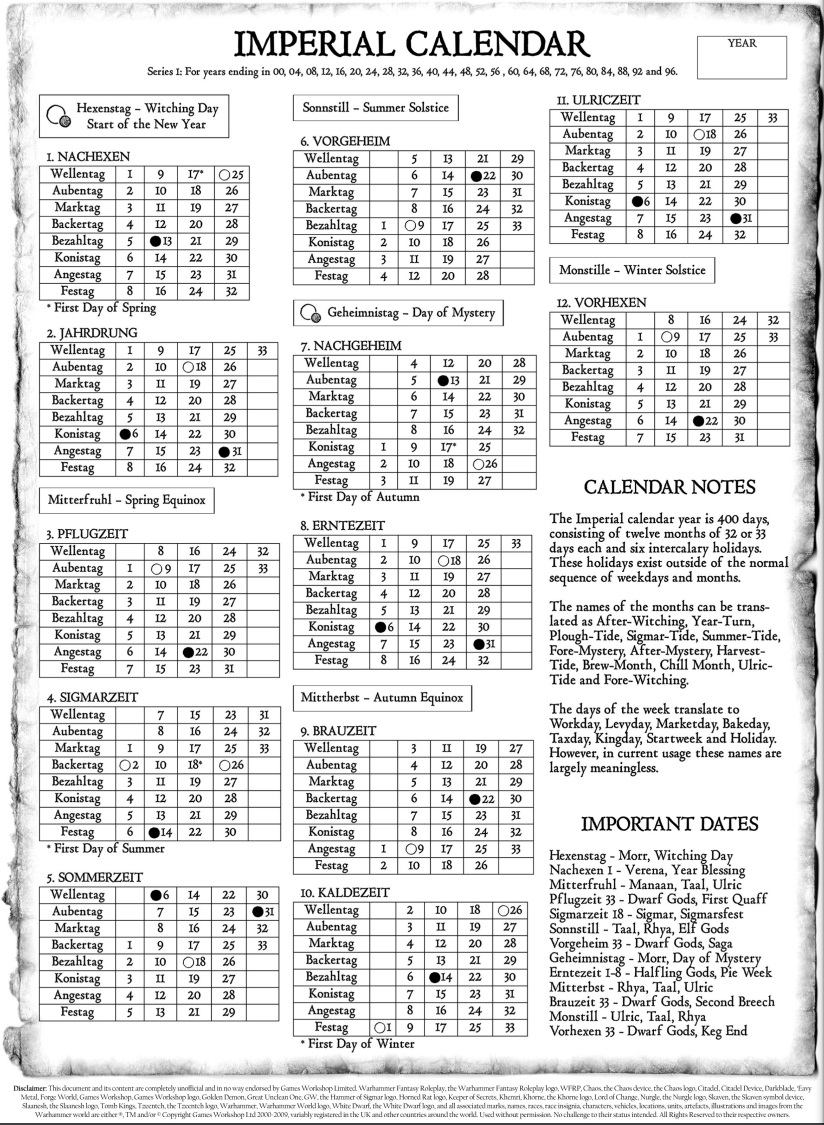
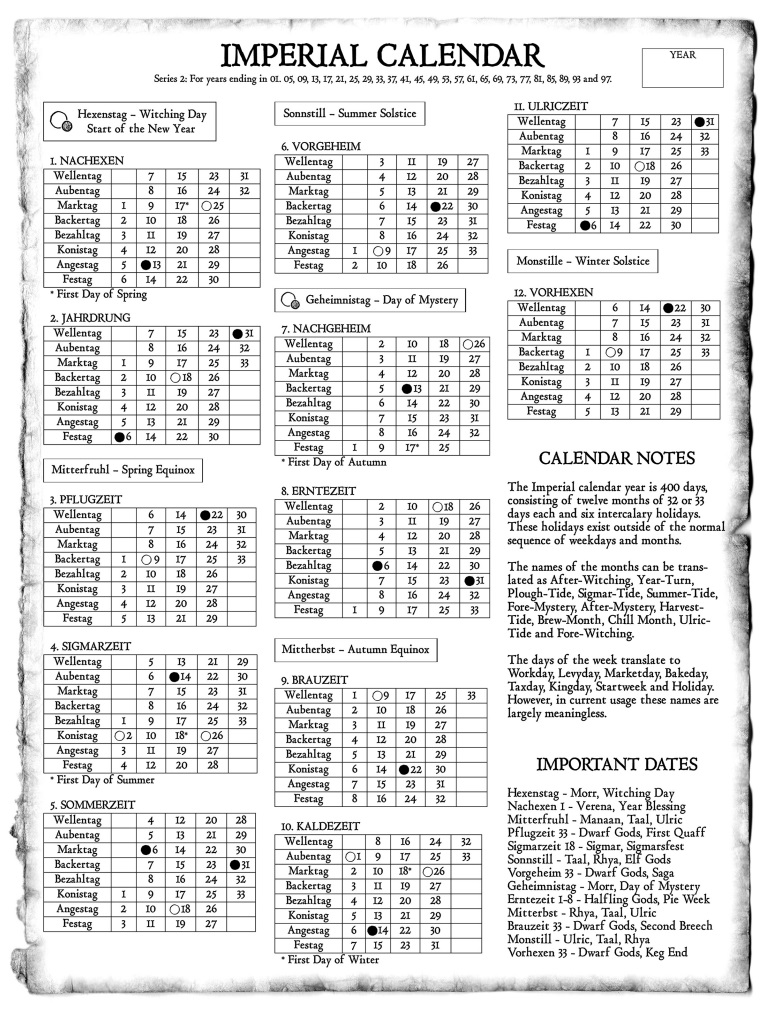
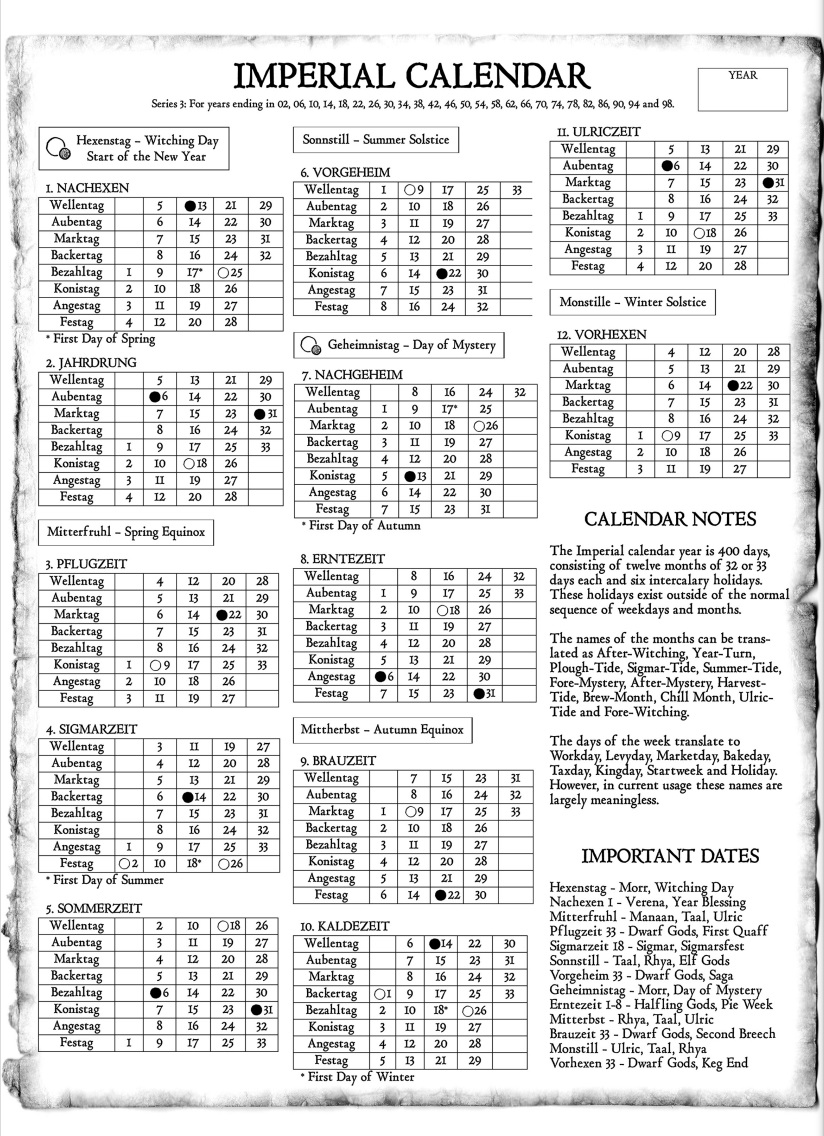
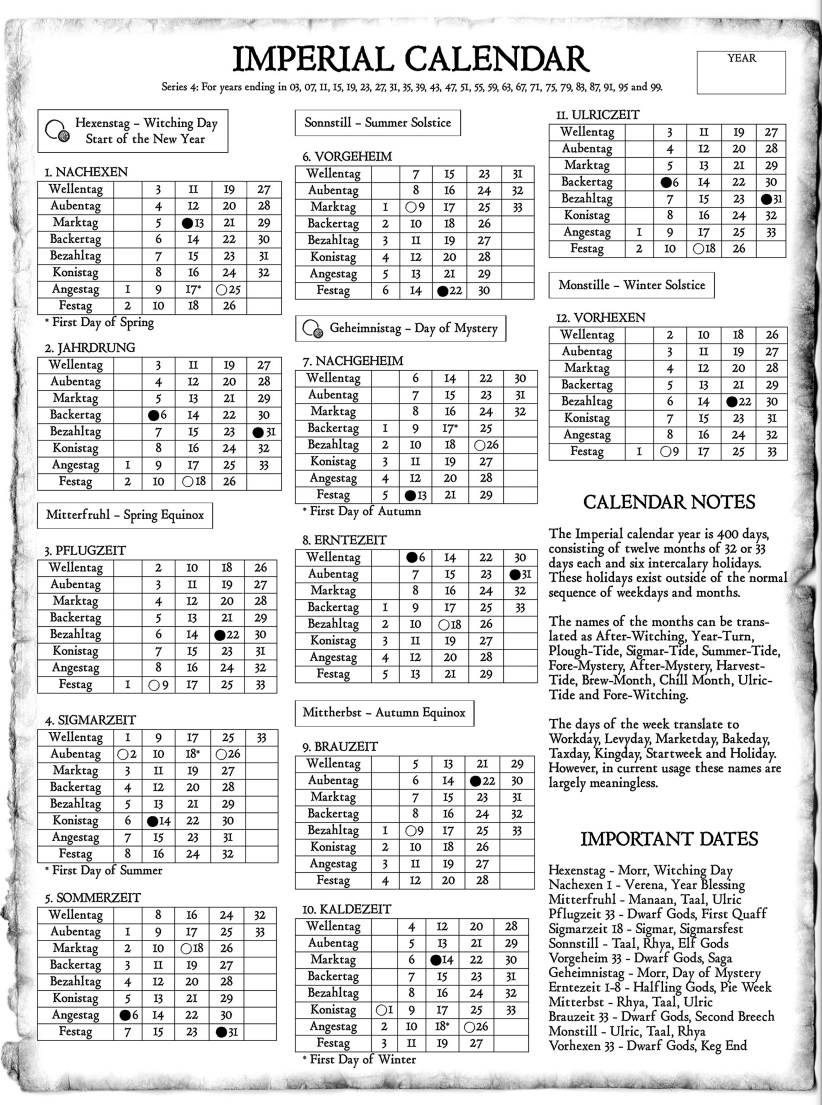

Comments